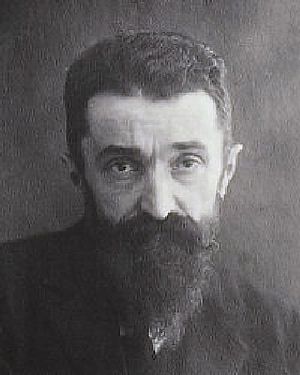Leonardo Bistolfi facts for kids
Quick facts for kids
Leonardo Bistolfi
|
|
|---|---|
 |
|
| Born | 14 March 1859 Casale Monferrato
|
| Died | 2 September 1933 (aged 74) La Loggia
|
| Nationality | Italian |
| Education | Accademia di Belle Arti di Brera |
| Known for | Sculpture |
| Movement | Symbolism Stile Liberty |
Leonardo Bistolfi (born March 14, 1859 – died September 2, 1933) was an Italian sculptor. He was a very important artist in the Italian Symbolism art movement.
Contents
Biography
Leonardo Bistolfi was born in Casale Monferrato, a town in Piedmont, north-west Italy. His father, Giovanni Bistolfi, was also a sculptor who worked with wood. His mother was Angela Amisano.
In 1876, Leonardo started studying art at the Brera Art Academy in Milan. His teacher there was Giosuè Argenti. Later, in 1880, he continued his studies under Odoardo Tabacchi at the Accademia Albertina in Turin.
His Sculptural Work
Early Artworks
Between 1880 and 1885, Bistolfi created some of his first sculptures. These included pieces like Le lavandaie (meaning ‘The Washerwomen’) and Tramonto (‘Sunset’). Other early works were Vespero (‘Evening’), Boaro (‘Cattle-hand’), and Gli amanti (‘The Lovers’). These early pieces showed the influence of a Milanese art style called Scapigliatura.
In 1882, he sculpted L'Angelo della morte (‘The Angel of Death’). This was for the Brayda family tomb in the Cimitero Monumentale cemetery in Turin. A year later, in 1883, he made a bust of the painter Antonio Fontanesi for the Accademia Albertina. These two works marked a change in his style. He began to move towards Symbolism, an art movement he would continue to follow.
Portraits and Famous Figures
From the 1880s until 1914, Bistolfi created many busts, medals, and portraits. He sculpted important people of his time. These included the painter Lorenzo Delleani and the kings of Italy, Vittorio Emanuele II and Umberto I. He also made portraits of the criminologist Cesare Lombroso, the writer Edmondo De Amicis, and the publisher Emilio Treves.
Artistic Leadership and Recognition
In the early 1890s, Bistolfi became an honorary member of the Accademia Albertina. He also took on the role of secretary for the Circolo degli Artisti (‘Artists’ Circle’).
From 1892 to 1894, he worked on decorating Chapel XVI of the Sacro Monte di Crea. This is one of the Sacri Monti of Piedmont and Lombardy, which are special religious sites recognized by UNESCO as World Heritage Sites.
In 1893, Leonardo Bistolfi married Maria Gusberti.
Funerary Monuments and Exhibitions
Between 1892 and 1908, Bistolfi created many monuments for tombs. These included statues and reliefs, such as the memorial plaque for André Gladis.
In 1902, he helped start an art magazine called L'arte decorativa moderna (‘Modern Decorative Art’). He founded it with other artists like Davide Calandra and Giorgio Ceragioli. Between 1895 and 1905, he showed his artworks at several Venice Biennale exhibitions.
Major Public Works
In 1906, Bistolfi created a monument dedicated to the painter Giovanni Segantini. This sculpture is called La bellezza liberata dalla materia (‘Beauty liberated from matter’), also known as L'alpe (‘the Alp’). It is now kept at the Galleria Nazionale d'Arte Moderna in Rome.
He also contributed to the grand Monument of Vittorio Emanuele II in Rome. For this monument, Bistolfi sculpted a marble group called Il sacrificio (‘Sacrifice’).
Later Life and Legacy
In 1923, Bistolfi was honored by being made a Senatore del Regno (Senator of the Kingdom). This was a high political position in Italy.
In 1928, he created the Monumento ai Caduti (a war memorial) for his hometown of Casale Monferrato.
Leonardo Bistolfi passed away in La Loggia, near Turin, on September 2, 1933. He was buried in the cemetery of Casale Monferrato.
His sculptures can be seen in many places around the world. You can find his work in La Loggia, at the Musée d'Orsay in Paris, and at The National Museum of Western Art in Tokyo. There are also pieces at the Galleria d'Arte Moderna in Turin.
The largest collection of his work is at the Gipsoteca “Leonardo Bistolfi” in Casale Monferrato. This museum has over 170 of his artworks displayed in five rooms. These include drawings, sketches, and sculptures made from terracotta, plasticine, gesso, marble, and bronze.
You can also find Bistolfi's sculptures in the Cimitero monumentale di Staglieno in Genoa. His style influenced many other sculptors in Genoa, especially those who created art for tombs.
Images for kids
See also
 In Spanish: Leonardo Bistolfi para niños
In Spanish: Leonardo Bistolfi para niños


